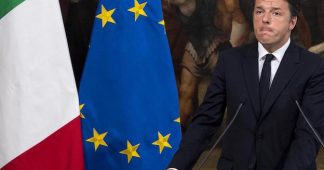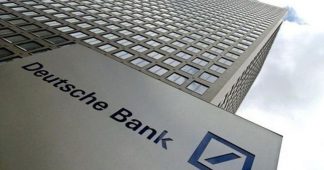By DICK NICHOLS
The tribulations of major European banks, starting with “venerable institutions” like the Monte dei Paschi di Siena (the world’s oldest bank) and Deutsche Bank (Germany’s largest), have raised the spectre of a repeat of the crash of 2008 — a “Lehman Brothers times five” in the words of one market analyst.
Deutsche Bank has been found to be seriously under-capitalised, both according to the standards set under the Basel III international bank regulation standards and according to its own targets. The same goes for British giant Barclays.
The immediate cause of Deutsche Bank’s predicament was the US Justice Department’s insistence in early September that it pay US$14 billion in compensation for peddling worthless mortgage-backed securities to US housing finance providers Fannie Mae and Freddie Mac before the 2008 crash.
However, according to Financial Times commentator Martin Wolf, Deutsche Bank is also “structurally weak … [and] highly leveraged by the standards of its peers. Roughly half of its €1.8 trillion in assets are linked to its trading activities, with a significant proportion of those assets (€28.8 billion, in total) without market prices.
“Even by the standards of its peers, it is a highly-leveraged bank with a doubtful business and opaque assets.”
Monte dei Paschi is a simpler case. The only major bank to fail the European Banking Authority’s (EBA) most recent stress test, it has lost €15 billion over the past five years because it has nearly €30 billion in non-performing loans on its books.
A plan developed to save Monte dei Paschi involves slashing 2500 jobs, closing 500 of its 2000 branches, selling-off its non-performing loans and its payment processing system, and raising capital through a debt-to-equity swap and a €5 billion share issue.
By October 27, Deutsche Bank shares were trading at €14.60, one-tenth of its 2007 high point. On the same day, trading in Monte dei Paschi shares was suspended after they fell to €0.27 on the announcement of the restructuring plan. In 2007 they had reached a high of €108.52.
Debt and insolvency threat
These enormous collapses in share value would seem to confirm the predictions of impending disaster. In January, for instance, Royal Bank of Scotland (RBS) economists infamously told clients to “sell everything except high quality bonds”.
Moreover, this apocalyptic prospect has not just been pushed by bearish financial commentators in search of a scary headline.
Former Bank of International Settlements (BIS) chief economist William White told the US National Association of Business Economists on September 11: “The situation we face in late 2016 … is arguably more fraught with danger than was the case when the crisis first began. By encouraging still more credit and debt expansion, monetary policy has dug the hole still deeper.”
White, one of the few mainstream economists to predict the 2008 crash, concluded that “the fundamental problem is one of excessive debt and possible insolvency. Such problems must be solved by governments, not central banks.”
White, now employed by the Organisation for Economic Cooperation and Development (OECD), proposed that “debt restructuring and outright forgiveness must be used much more aggressively … major increases are required in public investment in infrastructure … governments should use what measures they still have at their disposal to increase aggregate demand.”
The troubles of Deutsche Bank and Monte dei Paschi di Siena are only the most extreme expressions of a debt-induced “zombification” of the European banking sector.
On October 5, EBA chair Andrea Enria outlined the situation: “The problem is European in scale: we have more than €1 trillion of gross non-performing loans in the system; even considering provisions [against loan default], the stock of uncovered non-performing loans is at almost €600 billion — more than all the capital banks raised since 2011, more than six times the annual profits of the EU banking sector, more than twice the flow of new loans…
“For supervisors, this casts serious doubts on the long term viability of significant segments of the banking system. The same concern is shared by investors and is reflected in the low valuations registered in stock markets.”
Shrinking assets
This state of affairs exists despite the European banking system receiving €1.6 trillion in taxpayer support since 2008 and while the European Central Bank (ECB) makes €80 billion a month available in life-support financing.
So why are major banks still in such dire straits? What has happened to this vast pool of monetary support?
The source of the mess lies not only in the banks’ vast legacy of non-performing loans, but also in the generally stagnant economic environment in which they have had to operate since 2008. This has been marked in Europe by the 2009–10 and 2012–13 double-dip recession.
Also, measures forced on bank regulatory authorities by the financial crisis, mainly the increase in capital requirements under the Basel III agreement, have secured any gains in system stability at the price of reduced profitability.
However, the main pressure squeezing bank profitability has come from the subdued demand for loans, the main asset class on bank balance sheets. This stagnation in credit demand is due to big business being more reluctant to invest and, in any case, more able to fund any investment undertaken out of its hundreds of billions in retained profits.
At the same time, given their experience of non-performing loans, banks have raised interest rates and tightened borrowing conditions for non-prime borrowers, typically small and medium business. But due to low, even negative interest rates, they have had to accept narrower margins on loans to their more reliable customers.
Matters are worse on the “periphery” (Spain, Portugal, Greece, Ireland, Italy and Cyprus). Between 2007 and 2015, investment in these countries, as measured by gross fixed capital formation, crashed from an average of 25.9% to 20.9% of Gross Domestic Product.
As a result, while bank credit to non-financial business for the whole of the Eurozone was negative from the beginning of the crisis in 2008 until the end of 2013, for the distressed economies of this “periphery” it crashed by 5% a year from 2008 to 2013.
ECB financing operations
The situation would have been even worse had it not been for the European Central Bank’s longer-term refinancing operations (LTRO), begun in late 2011.
The LTRO handed banks hundreds of billions at 1% interest, which they overwhelmingly invested in government bonds at higher interest rates: this was money for jam that helped banks reduce their own indebtedness at the expense of government budgets, in which loan repayment became an ever larger item.
Finally, by the start of 2014, there was a mild pick-up in bank lending to business that was reinforced by the ECB’s next initiative — targeted longer-term refinancing operations (TLTRO). This was a program to give banks money on condition that these funds were used to finance credit to small and medium business and not to speculate on the bond market or real estate (a major fate of LTRO funds).
However, by the end of last year, the TLTRO had also run out of steam. Banks were increasingly not taking up the ECB’s very generous offer because demand for credit was simply not there.
In the words of one anonymous finance commentator cited on the Zero Hedge website: “The lack of positive real expected returns dampens new investments in hiring plans, plant and machinery, and related borrowing and credit formation with it.
“Thus, [ECB president Mario] Draghi’s move was just another artefact of financial leverage, not a game changer.”
In short, the end result of the ECB’s expansionary monetary operations was to help sustain what very mild growth there has been in the Eurozone since 2013, but at the cost of producing overvalued and increasingly volatile financial markets.
Knife edge
In this highly unstable context, bad news about a financial institution can quickly send it on the road to ruin. If investors and depositors fear their bank is in danger of failing and so pull their money out, they will produce the bank run that destroys it.
This is the brink on which both Deutsche Bank and Monte dei Paschi di Siena now sit: they are at the point where paper thin confidence in their future could give way before any more bad news, producing the “rush for the exits” that sank Lehman Brothers in 2008.
If Monte dei Paschi failed, it could probably be incorporated into some other Italian bank, just as Bear Stearns and other failing banks were snapped for a song by JP Morgan in the run up to 2008.
However, a Deutsche Bank failure would be qualitatively more destructive. This is because of the sheer size of its obligation’s to other major banks, including central banks, and the range of its trading activities.
The latest news from Deutsche Bank is that it lost 5% of its total deposits and 13% of its demand deposits in the July-September quarter — suggesting the possible start of a bank run. If this is the case, intervention from the German government of Angela Merkel cannot be far off.
The German chancellor has said that the government has no intention of intervening to help the bank. But this is an institution that really is too big — and too connected with the rest of the European and global financial system — to be allowed to fail.
If matters reach such an extreme — requiring even more taxpayer funds than have been used in bank rescues and consolidations to date — the European financial system might survive one more round, but at what political price?
[Dick Nichols is Green Left Weekly’s European correspondent. A more detailed version of this article will soon appear at Links International Journal of Socialist Renewal.]











